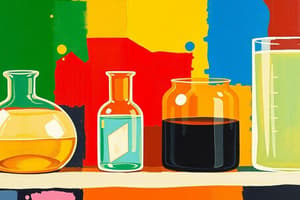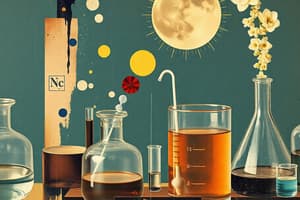Podcast
Questions and Answers
Which chemical formula represents chlorophyll?
Which chemical formula represents chlorophyll?
- C37H29N3O9S3
- C29H15N5O9S2
- C55H72MgN4O5 (correct)
- C41H26N2O8
What is the primary use of the separating funnel method?
What is the primary use of the separating funnel method?
- To separate immiscible liquids (correct)
- To determine boiling points
- To purify solid samples
- To measure refractive indices
Which method can be used to determine the boiling point of a substance to assess its purity?
Which method can be used to determine the boiling point of a substance to assess its purity?
- Visual Inspection
- Boiling and Melting Point Determination (correct)
- Inhalation (Olfaction)
- Refractometry
In which scenario would the mixed melting point method indicate that an unknown sample is pure?
In which scenario would the mixed melting point method indicate that an unknown sample is pure?
What is the role of refractometry in determining purity?
What is the role of refractometry in determining purity?
What is indicated by a wide range of melting points in a substance?
What is indicated by a wide range of melting points in a substance?
Which technique is NOT commonly associated with determining the purity of a substance?
Which technique is NOT commonly associated with determining the purity of a substance?
What is the primary purpose of sieving in separation techniques?
What is the primary purpose of sieving in separation techniques?
Which method is used to recover a solid from a solution?
Which method is used to recover a solid from a solution?
Which of the following methods could be used to separate an insoluble solid from a liquid?
Which of the following methods could be used to separate an insoluble solid from a liquid?
What characteristic is necessary for simple distillation to be effective?
What characteristic is necessary for simple distillation to be effective?
In chromatography, what primarily determines the separation of substances?
In chromatography, what primarily determines the separation of substances?
Which separation technique involves adding a precipitating agent?
Which separation technique involves adding a precipitating agent?
When using fractional distillation, which factor is crucial for its effectiveness?
When using fractional distillation, which factor is crucial for its effectiveness?
Which of the following is an example of a substance that sublimates?
Which of the following is an example of a substance that sublimates?
Flashcards
Sieving
Sieving
A method used to separate a mixture of different particle sizes, such as sand and gravel.
Sublimation
Sublimation
The process where a solid changes directly into a gas without passing through the liquid state.
Magnetization
Magnetization
A technique used to separate magnetic substances from non-magnetic substances.
Filtration
Filtration
Signup and view all the flashcards
Residue
Residue
Signup and view all the flashcards
Filtrate
Filtrate
Signup and view all the flashcards
Simple Distillation
Simple Distillation
Signup and view all the flashcards
Fractional Distillation
Fractional Distillation
Signup and view all the flashcards
Separating Funnel Method
Separating Funnel Method
Signup and view all the flashcards
Recrystallization
Recrystallization
Signup and view all the flashcards
Determination of Purity
Determination of Purity
Signup and view all the flashcards
Visual Inspection
Visual Inspection
Signup and view all the flashcards
Inhalation (Olfaction)
Inhalation (Olfaction)
Signup and view all the flashcards
Boiling and Melting Point Determination
Boiling and Melting Point Determination
Signup and view all the flashcards
Mixed Melting Point Method
Mixed Melting Point Method
Signup and view all the flashcards
Study Notes
Separation Techniques
- Sieving separates mixtures of different particle sizes, like sand and gravel.
- Sublimation is a phase change where a solid directly turns into a gas without becoming a liquid.
- Examples include ammonium chloride (NH4Cl), naphthalene, menthol, and dry ice.
- Magnetization separates magnetic substances from non-magnetic ones.
- Filtration separates an insoluble solid from a liquid.
- The solid retained on the filter paper is the residue.
- The liquid passing through is the filtrate.
- Decantation involves carefully pouring off a liquid from a solid, often using a glass rod.
- Centrifugation spins a mixture in a centrifuge to separate an insoluble solid from a liquid.
- Evaporation to dryness recovers a solid from a solution by evaporating the liquid.
- Crystallization recovers a pure dissolved solid from a solution.
- Techniques include adding a seed crystal, scratching the container, shaking, or using a nucleation site.
- Precipitation separates an insoluble solid from a solution using a precipitating agent.
- This agent forms a precipitate which can be separated via filtration or decantation.
Simple Distillation
- Separates miscible liquids with boiling points differing by at least 25°C.
- Example: Separating water and ethanol.
Fractional Distillation
- Separates miscible liquids with boiling points closer than 25°C.
- Example: Separating gasoline from crude oil.
Chromatography
- Separates substances based on different movement rates along a medium (paper or gel).
- Separates colored and colorless substances.
- Types include: Absorption, Partition, Paper, Column, Thin Layer, Gas-Liquid, and Gas-Solid Chromatography.
Examples of Chromatography
- Separates ink and chlorophyll components.
- Chlorophyll's major constituent is magnesium.
- Blue ink's chemical formula is C37H29N3O9S3.
- Chlorophyll's chemical formula is C55H72MgN4O5.
Separating Funnel Method
- Separates immiscible liquids, like water and oil.
Recrystallization
- Purifies an impure solid sample.
Determination of Purity of a Substance
- Techniques include:
- Visual Inspection: Observing color and appearance.
- Inhalation (Olfaction): Detecting odors.
- Boiling and Melting Point Determination: Pure substances have sharp melting/boiling points; impure ones have ranges.
- Mixed Melting Point Method: Mixing a pure sample with an unknown; a sharp melting point suggests purity; a wide range indicates impurity.
- Refractometry: Measuring refractive index to compare with literature values for pure substance.
Studying That Suits You
Use AI to generate personalized quizzes and flashcards to suit your learning preferences.




